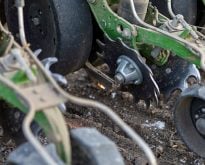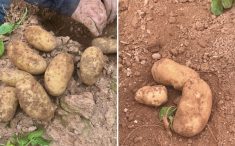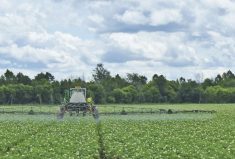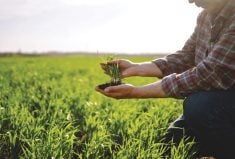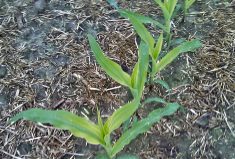Intercropping has potential, but the bigger bucks may be in cutting nitrogen
The announcement of the Federal Greenhouse Gas Offset System in early March brings more Canadian farmers closer to being paid for storing carbon, but there is more to be sorted out before this becomes a reality.
Progress is expected this year in the form of details for the first four protocols, one of which applies to farming: “Adoption of sustainable agricultural land management activities to reduce emissions and enhance carbon sequestration in soils.” Eventually, more ag-related protocols will be added relating to livestock feed management, manure management and avoiding grassland conversion.
Read Also

Could crop sharing be a viable option for your farm?
Crop sharing could be a good option for young and beginning farmers.
It’s expected that this new federal plan will integrate with the protocols in the existing carbon markets in B.C., Alberta and Quebec. Private firms are stepping up activities related to various protocols such as measurement of soil organic carbon (SOC) levels and how on-farm digital systems can be harnessed by farmers to efficiently track and verify their SOC sequestration. Nutrien is launching a pilot project in Canada and the U.S. that will focus on nitrous oxide (N2O) emission protocols. Terramera has a pilot project which includes 10,000 acres in the Peace River area of B.C. and Alberta. Farmers Edge has projects in both Canada and the U.S.
Practices that qualify
In the past, some Canadian farmers were able to sell carbon credits relating to reduced tillage or perennial forage coverage, but under the new federal scheme, these now-widespread practices will not qualify. However, Mario Tenuta, senior industrial research chair in 4R Nutrient Stewardship at the University of Manitoba, says there are other practices that can gain SOC buildup for Prairie farmers.
Tenuta says summerfallow reduction has been the largest contributor to SOC buildup, followed by direct seeding. SOC can also be increased through spreading more manure, diversifying crops and the use of cover crops.
“Reduction of fallow has already been achieved but there’s always some unintentional fallow where growers couldn’t seed due to bad spring conditions,” Tenuta says. “Moving forward, I think it’s a good idea for growers to choose crops that provide a lot of residues and roots, and aim for the highest yield for their regions.
“They could also use cover cropping if they have enough heat and moisture in the fall, but I think they will be doing quite a bit of intercropping and underseeding. On the Prairies, conditions are often dry in the fall and the window can be short for planting cover crops, so I think we’ll see more use of cover crops during the growing season.”
There is already some intercropping on the Prairies, but there is room for more. Tenuta notes that canola-pea mixtures are not uncommon and organic pea area is growing. Intercropping is especially suitable for growers who have seed-cleaning equipment so they can harvest and separate both crops.
“Red clover has been used in corn and winter wheat in Ontario and Quebec, but other types of clovers and vetches would be more suitable for the Prairies,” Tenuta says. “We need some trials. Legumes are good because they fix their own N and don’t need extra fertilization. So if I was a grower looking at the carbon credit market, I’d work on establishing cover crops during the growing season, intercropping and underseeding so the cover crop can make it through the winter.”
And although tillage is mostly eliminated in much of the Prairies and generally won’t qualify for carbon credits, Tenuta says there may be opportunities.
“We’ll have an improvement in the next few years in terms of being able to use strip tillage focused on the seed row, or no till in areas with clay soils, for example the Red River Valley in Manitoba and the area around Regina in Saskatchewan. Researchers are working on how this can be done and that will enable carbon sequestration in these soils, but farmers in these areas are very interested in how they can increase soil health and SOC in these soils to get better yields. They are actively contacting me and other researchers, offering test sites, et cetera.”
Tenuta believes the fastest rate of SOC buildup that Prairie farmers could achieve is 0.5 to one tonne per acre per year.
“One tonne is possible — for example, a beef producer doing intensive rotational grazing and improving pasture management, and the most dramatic change will be improving grassland/forage productivity by grazing and improving fertility. Prairie croppers can get 0.5 (tonnes) if they haven’t tilled and are using certain crops, but may have a challenge to get to one tonne.”
Cutting down the N
Farmers across Canada and the world are already improving efficiency of nitrogen fertilizer application to save cost and reduce runoff, but since cutting N also cuts emissions of N2O, a powerful greenhouse gas, reducing it has carbon market value. Experts believe that implementation of N2O-reduction protocols will gain carbon credit benefits for crop farmers for at least two decades ahead, as many of the related protocols have not yet been widely adopted.
“We have to continue using the 4R paradigm and we need more innovation with it, but it’s coming because the federal government has committed to a major N2O reduction by 2025,” Tenuta says. “The number of enhanced-efficiency fertilizers is growing and they reduce ammonia and N2O, among other molecules. With N placement, there’s a trend to broadcast spreading and not incorporating it into soil, but placement must be kept to where it’s needed. I think we’ll see more split application with corn and maybe canola. We are doing intensive research to determine adjustments with 4R practices and variable-rate prescriptions.”
Doug Cornell, based in the Calgary area, is part of the Farmers Edge technical product management team, He believes reducing N2O emissions should play a big role in the Canadian ag carbon market.
“A protocol for N2O management that is based on 4R principles ensuring more of the N applied gets into the crop instead of into the environment should be popular,” he says. “The farmers would make more money, before any carbon credit, by being more efficient with their nitrogen. The farmers can either lower their nitrogen bill and maintain their yields, or, if optimizing their yields using 4R best management practices, they may be able to apply more nitrogen as long as it is being consumed for the crop for higher yields, and still not have nitrogen escaping into the environment.”
Cornell says the success of the tillage protocols in Alberta matched and encouraged a growing trend in no till, and was relatively simple to administer and applied to many farms.
“Any N2O protocol must be constructed the same way, catching a growing commitment to precision agriculture and variable-rate nitrogen management. It has to be simple to administer and apply to many farms, and a well-designed 4R protocol can do those two things.”
Tenuta believes a typical Prairie farmer could trim N2O losses by 0.2 to 0.3 lbs. of N/ac., which translates to 105 lbs. (0.15 tonnes) of CO2/ac. The federal govern- ment has set a goal of $50/tonne by 2022.
“At a carbon credit price of $50 a tonne, that’s $7.50 per acre,” he says. “This is conservative and applies to the semi-arid areas, so there could be bigger benefits in the more humid areas of the Prairies. This will pay for your efforts to change your practices, plus the company that will measure and verify your practices, and the credit aggregator’s cut. So, I think a carbon credit price of $50 per tonne is the entry point for it to be worthwhile for farmers and as the price gets higher, you will have more and more farmers interested in it.”



